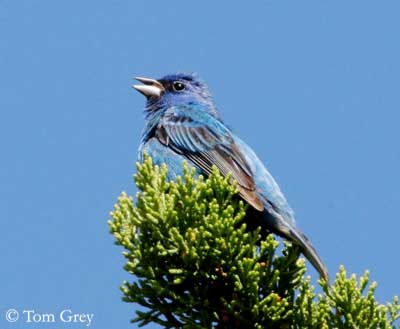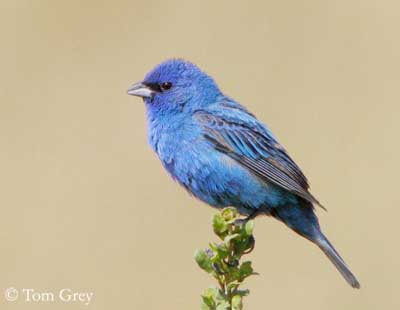
Indigo Bunting
Passerina cyanea
Passeriforme Order – Cardinalidae Family
BIOMETRICS:
Length: 11, 50-13 cm
Weight: 12-18 g
LONGIVITY: Up to 10 years
DESCRIPTION:
Adult male breeding Indigo Bunting is unmistakable. The only relief from its overall bright blue plumage is the two-toned bill, with black upper mandible, and grey lower.
It has a short, conical bill, and black or grey legs and feet.
Adult male winter is browner, due to extensive brownish feathers fringes, but blue still apparent on rump, tail and wings, and often elsewhere.
PROTECTION / THREATS / STATUS:
Brooding females, eggs and young are vulnerable to predation from raccoons, opossums, red foxes, feral cats and blue jays. Indigo Bunting is occasionally killed for sport and food. It is also a popular cage bird in Europe and Mexico.
Indigo Bunting appears to be increasing in geographic range.
Fr: Passerin indigo
All : Indigofink
Esp : Azulillo Norteño
Ital : Ministro
Nd : Indigogors
Sd : Indigofink
Photographs by Bob Moul
His website :
Nature Photography
Photographs by Tom Grey
His website : Tom Grey's Bird Pictures
Text by Nicole Bouglouan
Sources:
A GUIDE TO THE BIRDS OF MEXICO AND NORTHERN CENTRAL AMERICA by Steve N. G. Howell, Sophie Webb - Oxford University Press - ISBN: 0198540124
BIRDS OF THE GREAT BASIN – by Fred A. Ryser - Univ of Nevada Pr -ISBN: 0874170796
FIELD GUIDE TO THE BIRDS OF NORTH AMERICA - National Geographic Society - ISBN: 0792274512
THE HANDBOOK OF BIRD IDENTIFICATION FOR EUROPE AND THE WESTERN PALEARCTIC by Mark Beaman, Steve Madge - C.Helm - ISBN: 0713639601
All About Birds (Cornell Lab of Ornithology)
Animal Diversity Web (University of Michigan Museum of Zoology)
What Bird-The ultimate Bird Guide (Mitchell Waite)
Wikipedia (Wikipedia, The Free Encyclopedia)

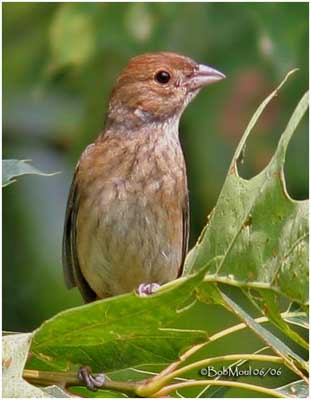
Adult female is warm brown above, and paler below, with some diffuse streaking on breast, and with paler edges to wing feathers, sometimes forming indistinct paler wing bars.
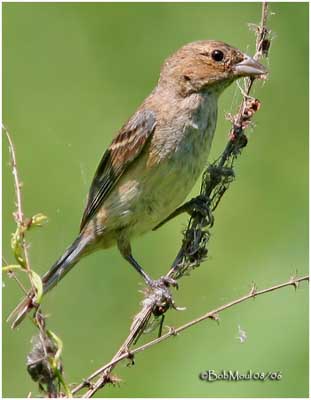
Some birds show a few scattered blue feathers in body plumage, and a blue tinge to tail and wings.
First winter in autumn, has more streaking below than adult female.
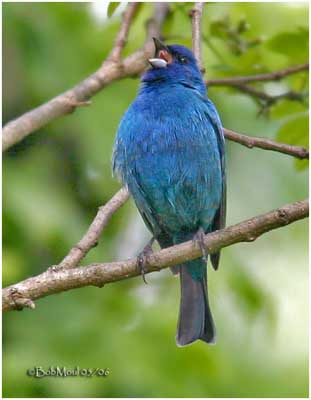
VOICE:
Indigo Bunting’s calls include a sharp “tzik” and a short buzzed “bzeet”. Its song is a variable series of clear, quick, high-pitched phrases, descending in pitch, and fading towards end.
HABITAT:
Indigo Bunting in natural range breeds in brushy and weedy fields and roadsides, bushy thicket, especially by water, and woodlands clearings and edges.
During migration, it prefers open grasslands and leafy trees.
In winter, it prefers open habitats, such as weedy fields, citrus orchards, savannas and weedy croplands.
RANGE:
Indigo Bunting breeds throughout eastern North America, from the Great Plains eastward, south of the coniferous forest region, and some populations in Utah, Arizona and California. It winters in the coastal regions of Mexico, Central America, Northern South America and Caribbean.
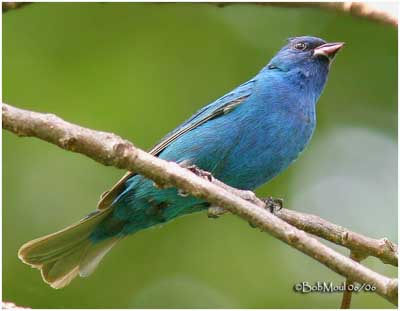
BEHAVIOUR:
Indigo Bunting is usually solitary. Male establishes and defends a territory where it may hold one or more females.
In winter, it roosts in flocks at night, but spends the day foraging alone during the breeding season and in flocks during winter. It is a migratory bird.
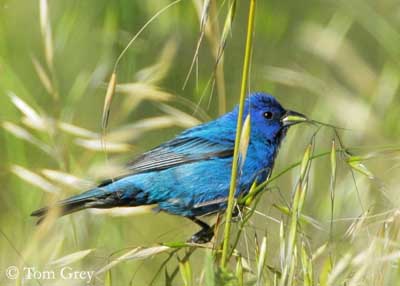
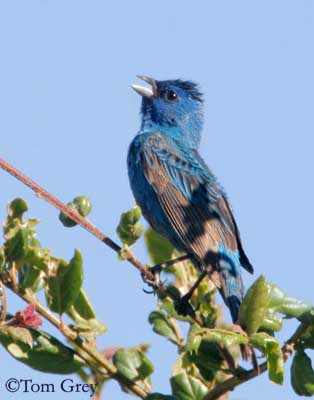
During breeding season, male sings. It has one complex song, to advertise occupancy of a territory to other males, and to attract females.
It performs courtship displays, strutting in circles in front of a female, with its wings spread and its head crouched. Indigo Bunting is monogamous, but it’s not uncommon to see a male with more than one mate. They may raise more than one brood per season, and may switch nests or mates between broods.
When a predator approaches the nest, adults may feign injury and make a “chip-chip-chip” call to distract it, and lure them away from the nest. They do not mob predators.
FLIGHT:
Indigo Bunting migrates largely at night. It may fly as far as 3200 km between the wintering and the breeding areas.
REPRODUCTION:
Indigo Bunting female chooses the nest site, and builds the nest in about 8 days. It’s built in shrubs in fields, or at the edges of woods, roadsides and railways. It’s built with leaves, grasses, stems and strip of bark.
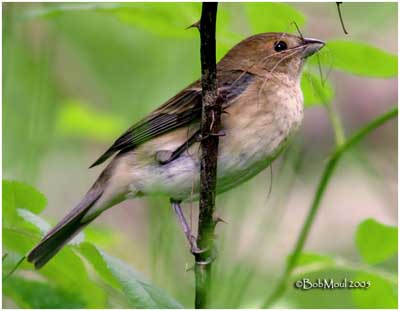
Female lays 1 to 4 white eggs, one egg per day, soon after sunrise. Incubation begins with the last egg laid, and lasts 11 to 14 days by female. She broods the chicks during the first days, and also feeds them with insects, and removes their fecal sacs from the nest.
Chicks leave the nest 8 to 14 days after hatching. They are independent about three weeks after fledging. They are sexually mature at one year old.
DIET:
During breeding season Indigo Bunting eats small spiders, insects, seeds of grasses and berries. They feed also on caterpillars, grasshoppers, bugs and beetles.
In winter, they eat small seeds, buds, and some insects. Their main food at this time includes seeds of grasses. They eat also the seeds of rice in the rice fields. It does not drink frequently, and may obtain sufficient water from their diet.
